FRACTAL OD and OC BOOKS are Released for ordering:
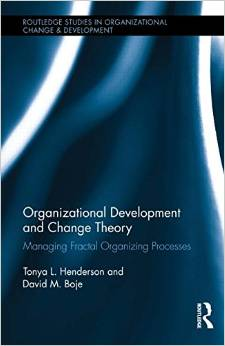
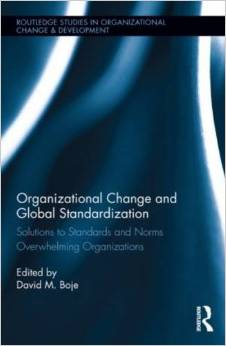
Boje's presentation slides, International Meeting of Academy of Management Research Methods Division
This material is copyrighted Boje. You are free to view, copy, print, and distribute this material from this site, as long as: 1. Material is used for information only; 2. Material is used for non-commercial purposes only. 3. Copies of any material include reference to author, title of page, web address. Thank you
Tonya Wakefield and I wrote OD and Change Theory: Managing Fractal Organizing Processes. And, the OC and Global Standarization, edited book: SOlutions to Standards and Norms Overwhelming Organizations. Both books: NY/London: Routledge.

This is a photo of a tetrahedron-fractal we constructed in a Fractal Change Management Ph.D. seminar. We are illustrating how fractal-narratives form out of repeated retelling of experience events among actors in a social network. As the tetraheadron-fractal takes its shape, the narrative-space it fills is hierarchical. However, laying about all all colors of antenarratives, represented by the toothpicks, and more experiences of life, the living stories not by brought into relationship, represented by the marshmallows. An antenarrative is defined as before-narrative coherence sets in, a bet on the future, what lies beneath the narrative order, and what occurs between the living story web and those recurring enduring grand narratives (Boje, 2014a, b; Boje, 2015, in press; Henderson & Boje, 2015, in press).
What is a fractal? "recurrence of self-similar and/or instability processes across scales: individual, unit, inter-unit, organizaiton, inter-organization, regional, international, global" (Boje, 2015). Fractals form in fractal narratives, fractal story webs, and are interconnected by transformative anatnarrative fractal processes.
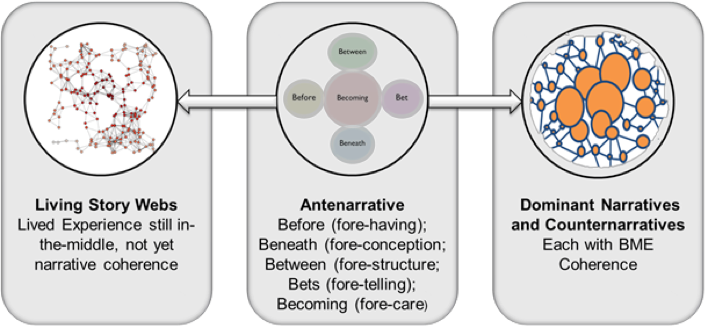
Here is a drawing done by Marita Svane, used in some articles, book chapter, proceedings, and presentations. For more on the B's of Antenarrative fractal connections, please see this Study Guide on Grand Narratives. (Click here to see the five B's in relation to the Hiedegger fore-'s; scroll half way into the document and you will find them).
Six teaching cases we use are at the following place (please orient yourself to the cases, and images, and come back here, for mre depth presenation).
WHAT IS FRACTAL STORYTELLING CONSULTING? Study Guide by David M. Boje
CASE ONE: Fractal-Branching of Departments in a College of Business
CASE TWO: GOLD Graphic Arts Consulting Firm
CASE THREE: Daniel Q. Boje's entreprenurship, Fractal-Spiral Story of the Trash Compactor (see full article pdf)
CASE FOUR: Fractal Analytics Consulting Company
CASE SIX: Tonya Henderson's Study of Fractal-Spirals
Fractal narrative’ is defined as “a narrative that finds its best accomplished form in the Web” in hyperlink networks (Durate, 2014: 284). A fractal-narrative is linear or cyclical in form, with a central monologic or monomythic structure, a heroic character, in a complex plot within plots, patterns within patterns — that repeats and repeats, from one telling to the next (Boje, 2015, in press).
Fractal and multifractal narratives grew in popularity across the social sciences after Benoit Mandelbrot’s 1970s work in fractal geometry. “Fractal narrative” is defined as “a narrative that finds its best accomplished form in the Web” in hyperlink networks (Durate, 2014: 284). Fractal narratives can take different forms, such as branching-fractal that keeps splitting into finer and fine subunits, a spiral-fractal which has amplifying iterations, and/or deviation counteracting iterations.
Warnecke (1993) metaphoric use of fractal to envision the ‘fractal company’ became inspiration for work in quality standards-fractals in production, planning and control (PPC) systems doing so-called flexible or agile manufacturing. The approach it top-down, and the focus is on the material resources of the ‘agile enterprise’ accomplishing self-organization and self-optimization, self-similarity, and vitalism dynamics, in a "hierarchical system” (Boje, 2014b; Boje, 2015, in press). Another version of fractal organization is by Hoverstadt (2008).He defines the fractal organization as a recursive map of an organization, but it is at the same time a hierarchical control. Hoverstadt says “business planning is still rooted in an annual cycle of targets and budget setting that is indistinguishable form the centralized planning systems of soviet Russia under Stalin” (p. 4). He applies fractal thinking to Stafford Beer’s “Viable System Model’. Both Warnecke (1993) and Hoverstadt (2008) have set the stage for Fractal Change Mangement (FCM). However, in order to move ahead we need to understand just what are the variations in fractal-narratives, and how we can change them.
Some of the narrative-fractal recrurr in ways that are monomythic (Palumbo, 1998, 2002, 2003, 2008). The monomyth is all around Hollywood filmes and most novels. It is that strange reduction and abuse of Joseph Campbell's Hero's Journey, turned into a formula, a reduction of life's complexity, by Hollywood, to serve to the mass audience. You can see the fractal-narrative turn into monomyth on the silver screen or in novels such as Dune series, the Star Trek series, the Staw Wars saga, The Matrix, Neuromancer, and the list goes on and on.
Fractal and multifractal narratives are also common in organizational monomythic fractal-narratives of how the solitary hero (usually the founder or current CEO) saved the day, and continue to reiterate across spaces and times of organizations and interorganizational networks (Henderson & Boje, in press; Boje, 2015, in press). It takes deep ethnographies, and sometimes fractal geometry to notice the antenarratives, the before-bets-beneath-between, the becoming of antenarrative-patterning.
Henderson and Boje (in press) argue that multifractal management is awareness of the patterns, alignment of actions to change the pattern-processes, and something called ‘antenarrative’ links between fractal-narratives (e.g. monomyth with one mono-plot, one hero or one villain), and multifractal story (e.g. living story webs moving every which way). An example: Jeff Noon’s (1993, 1996a,b) multifractal story meshwork of cyberpunk and postmodern surreal fictions constitutes a pattern Boje (2008, 2011, 2014a, b) calls the spiral-antenarrative, and it is always on the verge of becoming rhizomatic. There is often an ensemble of characters, rather than a central hero or heroine.
There are socioeconomic fractal patterns that occur over long swaths of history. Bruce Pugesek (2014) just came out with an article showing that there are fractal cycle turning points in the crises of social, economic, and ecology that when analyzed for patterns, look just like the Fibonacci-spiral fractal. Each interval “cycles forward and backward in time” in relation to the “next lower level in the Fibonacci sequence” (p. 159). Finally, Deleuze and Guattari (1987, chapter 14) apply the Mandelbrot-set fractal to the relation of smooth and striated spaces. Fractal narratives have become common in Hollywood movies and popular novels. Dune is an example of the centralizing, linear, centripetal fractal narrative, a monomythic saga.
In approaching Fractal Change Managment (FCM) there is more of less awareness of the storytelling processes that have gone fractal. The fractal is a meaning-making of the self, in relation to the ecosystem and our relations with others. This is a drawing from Tonya Henderson's (2012) dissertation of FCM. To carry out organizational change (or to manage strategic change), Henderson and I believe, involves awareness and attunement to turning points in the relation of organization adaptation to its environments (social, economic, political, cultural, ecological, etc.).

We have the basics of chapter materail that after much rewrite became the basis for the FCM book we are doing for Routledge.
Introduction
Part I: Fractal Management Theory‑ A Bold New Tool for a Brave New World
Chapter 1: What is Fractal Management Theory?
Chapter 2: Fractal Organizing Processes‑ An Operating Definition
Part II: Overview: Changing World, Changing Organizations, Changing Theory
Chapter 3: The Emergence, Systemicity, and the Post-Newtonian Worldview
Chapter 4: Complexity Meets Quantum Storytelling- Strange Attractors, Indeed
Part III: Exploring Fractal Organizing Processes in Situ
Chapter 5: From the Ashes: What We Can Learn from Non-profit Leaders During a Crisis
Chapter 6: The Search for Fractals- How Patterns in Storytelling Point Toward Deeper Meaning in Day-to-day Being
Part IV: The Fractal Manager’s Toolkit
Chapter 7:The Fractal Action Research Method
Chapter 8: A Fractal-based Strategic Change Model
Chapter 9: Ontological Systems Mapping‑ A Tool for Ethical Engagement
CONCLUSION
REFERENCES
How do you blend all the different fractals together —TO NORMALIZE across them all?
Organizations are constructed form fractal sets. These fractal sets are regular and irrregular fractals. Regular fractals exhibit self-similarity. Irregular fractas exhibit asymmetry. Social norms of organizations create both regular (self-similar) and irregular (assymmetrical) fractal sets. Both are generated in iteration after iteration.The math fractals (Mandelbrot Set, Koch Snowflake, Sierinski Triangle) are each idealizationas (ideal types form mathematical formulae). These ideal types can approaximate, but no not equal fractal patterns in nature. Mandelbrot (1983) recognized this:"Clouds are not spheres, mountains are not cones, coastlines are not circles, and bark is not smooth, nor does lightning travel in a straight line."
The implication is that grand narratives appoximate the living story web patterns in gross generalizations that tempt us to be unaware of the underlying fractal patterning. This narrative-grossness and story-particularness interact and interweave in antenarrative processes.
Tonya and I have a new theory to explain all this.
'New' INTRODUCTION
People can sense fractal patterns of organizational storytelling. This is most often below embodied-cognition (Lakoff) 'awareness.' Rather, our fractal storytelling 'awareness' on an ontological plane of Being-in-the-world. This ontological awareness involves a process of attunements of moods, alignments of actions, and antenarrative processes. All four processes (awareness, attunements, alignments, and antenarratives) intertwine in spacetimemattering. In other words, instead of embodied-cognition in a social constructivism paradign, we are a part of the paradigm shit to the growing field of sociomateriality.
Models of Social (S) and Materiality (M) in SocioMateriality Debates
The first model of sociomateriality is 'separation.' It is a Cartesian, agential cut, where socio is seen as apart from materiality, such as in subjective/objective split. René Descares (1596-1650) is the examplar of the Separation Model.

Figure 1 - Separation Model of S (social) and M (materiality) - drawing by Boje
The next model is Social Domination, the social dominates the material. It is exemplified on one of Aristotle's fourfold causalities, efficent cause (the blacksmith forges the material into a desired form, an iron sculpture).

Figure 2 - Social Domination Model of of Socio (S) Materiality (M) - drawing by Boje
The Social Domination Model of sociomaterialism is also known as the SHAPING MODEL, and harkens back to the social constructivist social science theories: the idea human social systems are the primary force in shaping material realities (Aristotle’s material, efficient, form and final fourfold causality.
Next, is the materialism dominance model, where the material dominates the social. In Aristotle's fourfold causalities, the 'material cause is the properties of the material itself are agential in limiting what the blacksmith can sculp the iron into. The matererial limits the socio options.

Figure 3 - Materialism Dominance Model - drawing by Boje
The M-->S model can be seen in the 'affordances' work done by web technologists, trying to write video games and web sites in ways that afford clues to the social, to the users, on how to navigate web pages. This has resulted in ethnogrpahies of how users learn to use search engines, and complex virtual spaces, and how to make these more usable, so humans can pick their way, and are sort of herded along, to follow the material-symbolic clues (knwoing which button to push, which icon to move your mouse over, etc.).
We contend that S-->M and M-->S models do not hold up. Empirical research by Cohn and Dourish (2014) does not find this sort of unidirectionality of human causal agents and material agency.
The next model attempts to 'balance' socio and material as equal forces of sociomaterialism.

Figure 4 - Balance Model of SocioMaterialism - drawing by Boje
This is also known as the harmony or symmetry model of sociomaterialism. In systems theory, it is the common traditional idea that systems are equilibrium-seeking. However, as we shall see this is a gross narrative generalizaiton, and ideal type in search of socio realizaiton.
Next is the model we know form Karen Barad's (2003, 2007) work on 'agential realism' the intra-activity of materiality with socio (discourse). She follows Bruno Latour (1999) in contending that the linguistic turn has gone too far, and there we need to look at quantum sociomateriality as intra-activity, rather than a interaction that is balance, or letting S-->M dominate or M--S dominate. The Posthumanist challenges of Barad, Bennett, Strand, Haraway, Hird, Henderson, and many other feminist sociomaterialists assert that humans have no primacy over other species.

Figure 5 - Intra-Activity Model of Sociomateriality - drawing by Boje
One way to theorize intra-activity is that the socio and the materialism fold into one another in quantum ways, rather than being in balance (equilibrium).
The newest candidate to explain the puzzle of how Socio and Materialism are related is the RE-CON-FIGURING MODEL by Dourish. In Re-Con-Figur-Ation there is a rocking back and forth, where sometimes, material-stuff on the ground matters, the materiality of the products, market sectors, technologies, and so on. And sometimes there are interventions from the degrading technologies forces a reorganization of both SOCIAL and MATERIAL practices.

Figure 6 - Re-Con-Figuring Model - drawing by Boje
Re-Con-Figuring Model looks at social aspects of materiality, and the materiality aspects of the social — seen as projections, rather than simpler SHAPING, SYMMETRY, or SHAPING kind of models. Cohn and Dourish (2014) pay attention to the representationalist practices that the materialism of technologies provide the social with. Things that do material-stuff, by social control of them in the world, and at the same time craft a representation of the world to us, that makes certain kinds of opportunities for action manifest.
For Cohn and Dourish (2014) it also takes a step beyond the intra-activity model of Barad. Re-Con-Figure-Ation ismore like sailing, a tacking back and forth that seems to work.
And as you can see in our 'sprial fractal' rendition of re-con-figuring, there is some patterning process about it, which Cohn and Dourish have not addressed. The fractal spiral figural practices of re-con-figuration, by which certain patterns of 'sociomaterialism' reality are produced, done again, and again, reiterating, always partial, and never complete system, is what Boje (2008, 2014) calls 'systemicity' (unfinalized, partial, overlapping, unfinished, series). And this fractal spiraling involves awareness-, attunement-, alignment-, and antenarrative-processes that is the topic of our book on Fractal Management.
There are other emerging models, such as narrative fractals.
Narrative Fractals - In social interactions with others, the narrative fractal pattern may influence what we opt to focus on as we quickly scan an environment.
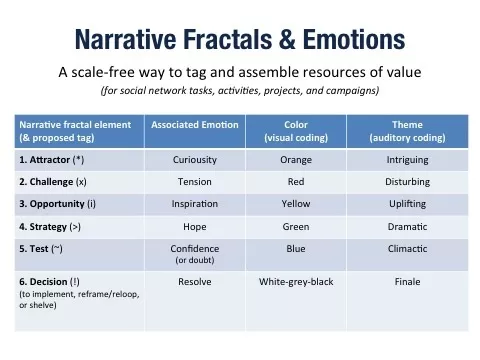
Figure 7 - Fractal Narratives - Mark Frazer http://www.quora.com/What-are-narrative-fractals
Attractor – interest-generating opener [emotion: curiousity]
Challenge – disruptor of settled understandings/relationships [emotion: tension]
(imagining)
Opportunity – vision of a desired outcome [emotion: inspiration]
Strategy – path to realize vision [emotion: hope]
(doing)
Test – trial to confirm strategy [emotion: confidence]
Followup – implement strategy, reframe/reloop, discard [emotion: resolve]
"A story will often have some kind of obvious target, maybe the intent of one of the players. "
Our Fractal Management book explores this and other new models of sociomaterialism.
Many of these are what is called linear fractals.
A linear fractal does translation, scaling, reflection, and rotation that rely on linear algebra (Notalle, 1994, 2011).
"My perspective: Fractals define and connect the story elements in a network. They do not, however, CHANGE the story, and change is where participation is most powerful. So to be effective as human beings and organizations, we need to understand the nature of fractals AND the phenomena of their changing, and of how new fractals, new patterns, emerge. Fractals are helpful for the growth and expansion of the networked narrative. They do not, however, account for the change in the narrative, i.e. when and why the pattern breaks and becomes a new pattern. i.e. No fractal can explain or account for the existence of another fractal, any more than Lolita can explain the existence of Phantom of the Opera. And yet, there is a scenario out there in the universe of possibilities, where Lolita and the Phantom fall in love and make music of their own. So we need more than narrative fractals, along with nodes and influencers, to define what's happening and where, in the network, are the opportunities for anything but bigness and expansion. We need Exploration and Newness, too. This means new stories, or at least new fractals composed of old ones. The Exploration and Newness happen at what Dr. Tonya Henderson calls the Inflection Points when the the fractals change, the patterns shift, and the story evolves in surprising ways as new fractals emerge. This is the area that interests me-- why (and when and how) does the story change?. Intution informed by education tells me fractals break and new patterns when certain histories (what we know, epistemology) meet a desired future (what we want, our intentions, ontology) in the present (where we encounter the ontic, or what I call "materiality" of the world). My colleague Dr Anete Strand, calls this The Between. My mentor, Dr. David Boje, calls it "Tamaraland" after the immersive theater play, Tamara, where the audience had to decipher what was happening in scenes staged in rooms throughout a large mansion via quick hallway encounters between scenes. In Tamara, the scenes with the actors were the narrative fractals. They were defined by time and space and the script. The Inflection points were the hallway encounters between members of the audience. Steve Jobs called hallway encounters like this "spontaneous collaborations." Our spontaneous collaborations are where stories really get interesting, and where we can discover their power to change the world. Thanks for this great and interesting topic, really worthy of a deep dive. Most appreciative."
Tonya,
We have cases we can put in each chapter and can then work on the concepts.
1. Wikia Fractal Story with GOLD
2. Fractal Narrative Mark Frazer
3. Mike Bonifer bigSTORY and BIGdata
4. TOnya Henderson - colorado fire
5. Nazanin - Sears and Wal-Mart
6. Boje - patent fractal spiral
7. Alissio entrepreneurial fractals of Italy entrepreneurs
8. Armando fractality of Mixio cartels-polices, etc.
FRACTAL STORYTELLING
Fractal Storytelling exists in and between organizations and ecosystems!
Fractal storytelling is defined here, as the study of the relationship between many small events in living story webs, brought into antenarrative processes into interactivity with the grander narratives of quite few events. Here we focuse on Awareness, Alighnment, Attunement, and Antenarrative processes that are as Bard (2003, 2007) puts it in dynamic 'intra-activity.'
Fractal storytelling consists of a combination of irregular and regularizing self-similar fractal storytelling behaviors. Self-similar factal narratives are repeated across scalles (micro to macro) of 'storytelling organizations' (Boje, 1995, 2008a). Irregular fractal stories do not exhibit the fractal-self-sameness imputed to grand narrative iterations. A random process cal lead to non-self-similar fractal storytelling.
Natural fractals have limit points, above and below which, the self-similar scalability stops after a few cross scale associaitons. Social norms of organizations change from one generation to the next, thereby creating transformations of the gractal structures of organizing. The generating norms and rules produce combinations of irregular and regular fractal sets. An everyday example is the formation of departments and colleges in universities, from one generation of faculty, students, and administrators---to the next. A fractal branching process occurs in which colleges are added, colleges split into two or more colleges, departments proliferate, often combining and splitting departments. Unlike a branc tree fractal, there are interdisciplinary relationships that form across departments (joint research, interdisciplinary minors and majors, joint appointments, etc.).
As the scale of a grand narrative becomes grander, more gneral, the precision of the evneness decreases, yet the coherence (simplicity) of it increases. More living story-ness is taken-for-granted, assumed, assimilated, and a reductinionism of facticity occurs in the grand narrating. Living story webs, on the other hand, generate differences, localities, and come into contradiction with grand narrative schemata. The scaling of eventness is different in grand narratives and living story webs. Grand narratives scale on very few events, and few characters, generating the illusion that other events and characters are marginal to organizing processes and outcomes. Living story webs, tend toward particularities within their vacinity of the web, and towards stereotyping what is non-local. Both go through iterative function-processes, we call antenarrating. The combination of the three (grand narratives, living story webs, & antenarrating processes) forms storytelling organization.
Fractal storytelling methodology can explore the complex dynamic process of systemities, as events are selected into narratives, and the grand events are differentiated into infinitesimally smaller event-ness, as the iterations proceed. Using diffeent fratal observaitn appartuses or measurement devices produces different understandings. Use a yardstick to measure a Koch Curve will yield different results than a milimeter-stick.
Fractal storytelling expresses the fractal patterns of practial organizaiton phenomena, including turbulence, social networking, emergence, growty, market niches, and ecosystem relations. unlike a state grand narrative, a living story web behaves with relationality, flows, folds, and the intra-activties of sociomateriality (interface of the social with the material) In the alternative scaling of storytelling event-ness, strange attractor dynamics produce such antenarrative patterns as swirls that produce spirals of symmetry and asymmetry. While organiations are rich in self-similar fractal sets, they are also rich in irregualr fractals, and in non-fractal random processes.
is a special type of dungeon that consists of an array of mini-dungeons called fractals, where each fractal has its own story and environment. Each difficulty scale requires the completion of four consecutive fractals, the fourth of which is called a boss fractal. The fractals are randomly selected from a small set. E.g. in Aquatic Ruins: The first step is to free three fishermen by killing all the krait surrounding the cell. After this, the fractal can differ: the deep path or the dolphin path. It is possible for only one party member to make it to the next checkpoint and then wipe, allowing everyone to checkpoint past the section. This can often saves time and repair costs for groups that are not familiar with the paths.
I would like to propose 3 experiential activities.
EXERCISE ONE : Construct
Sierpinski Triangle
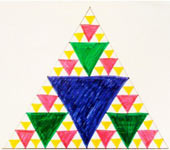
http://fractalfoundation.org/fractivities/FractalTriangles.pdf
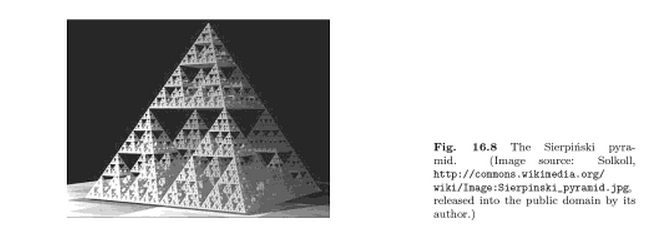 (Feldman, 2012).
(Feldman, 2012).
EXERCISE TWO: CONSTRUCT FRACTAL TREE OF UNIVERSITY's COLLEGES AND DEPARTMENTS

Divide into teams, with at least one person from a university.
http://fractalfoundation.org/fractivities/FractalTrees.pdf
This is an example of combination of self-similar and non-self-similar branching sets of fractals. e.g. click this example go to figure 4.
EXERCISE THREE: CONSTRUCT TETRAHEDRON OF ALL ORGANIZATIONS YOU WORK OR LIVE IN< IN YOUR TEAM>
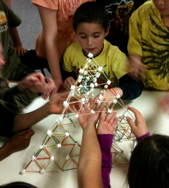
Be sure to open the marshmellow packages two or three days ahead, so they are firm enough to work with
http://fractalfoundation.org/fractivities/FractalTetrahedrons.pdf
Some References
Boje, David M. (2014a). Storytelling Organizational Practices: Managing in the Quantum Age. London/NY: Routledge.
Boje, David M. (2014b). Fractal Story and Fractal Ethnography of Entrepreneurial Sustainability: Daniel Q. Boje’s Trash Compactor Patents and Enterprise. Proceedings Paper for 4th Annual Quantum Storytelling Conference, December 17 – 19 2014, held at ‘Inn of the Arts,’ Las Cruces, New Mexico. http://business.nmsu.edu/~dboje/655/New_Materialisms_and_Systemicity.html
Boje, David M. (2015, in press). Change Solutions to the Chaos of Standards and Norms Overwhelming Organizations: Four Wings of Tetranormalizing. London/NY: Routledge.
Duarte, G. A. (2014). Fractal Narrative: About the Relationship Between Geometries and Technology and Its Impact on Narrative Spaces (Vol. 12). transcript Verlag.
Henderson, Tonya L.; Boje, David M. (2015, in press). Managing Fractal Organizing Processes. NY/London: Routledge.
Hoverstadt, P.: (2008). The Fractal Organization: Creating Sustainable Organization with the Viable System Model. John Wiley & Sons, Chichester.
Kamenshchikov, Sergey. (2014). Transport Catastrophe Analysis as an Alternative to a Fractal Description: Theory and Application to Financial Time Series, Journal of Chaos Volume 2014, Article ID 346743
Mandelbrot, B. (1977), Fractals: form, chance, and dimension (San Francisco: W.H. Freeman).
Mandelbrot, B. (1983), The fractal geometry of nature (New York: W.H. Freeman).
Noon, Jeff. “Books Top 10: Jeff Noon’s Favorite Fluid Fiction.” Guardian Unlimited 17 Jan. 2001. Online. 7 Jan. 2008.
─────. “Post Futurism.” The Guardian. 10 Jan. 2001. Online. 7 Jan. 2008.
─────. “Press Biography.” Jeffnoon.com. Online. 14 Feb. 2008.
─────. “Transcript: Jeff Noon Live Online.” Guardian Unlimited 16 May 2000. Online. 7 Jan. 2008.
─────. Vurt. 1993. London: Pan, 2001.
Santala, Ismo. “Jeff Noon.” The Modern World: The Scriptorium. 8 Oct. 2003. Online. 7 Jan. 2008.
─────. “Transmission > Reception: Interview with Jeff Noon.” The Modern World: The Scriptorium. 27 Dec. 2002. Online. 7 Jan. 2008.
Palumbo, D. (1998). The monomyth as fractal pattern in Frank Herbert's Dune novels. Science Fiction Studies, 433-458.
Palumbo, D. (2002). Chaos theory, Asimov's foundations and robots, and Herbert's Dune: the fractal aesthetic of epic science fiction (No. 100). Greenwood Press.
Palumbo, D. E. (2004). The Monomyth in Alfred Bester's The Stars My Destination. The Journal of Popular Culture, 38(2), 333-368.
Palumbo, D. E. (2008). The Monomyth in Star Trek Films. The Influence of Star Trek on Television, Film, and Culture. Ed. Lincoln Geraghty. Critical Explorations in Science Fiction and Fantasy, 4.
Pugeske, Bruce, H. (2014). Fractal cycle turning points: A theory of human social progression. Ecological Complexity 20:157–175.
Warnecke, H.-J. (1993). The fractal company: A revolution in corporate culture. Springer-Verlag, Berlin, New York.